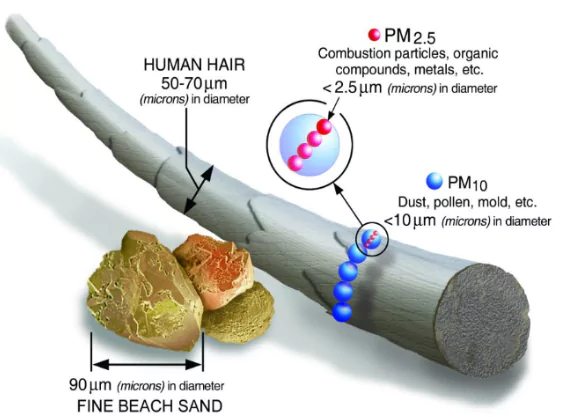A recent study by the Centre for Research on Energy and Clean Air (CREA) highlights the significant role of secondary pollutants, particularly ammonium sulphate, in contributing to PM 2.5 air pollution across India.
Primary vs Secondary Pollutants
- Primary pollutants are emitted directly from sources like vehicles, coal-fired power plants, and biomass burning. (e.g., Carbon monoxide , Sulfur dioxide, Nitrogen oxides)
- Secondary pollutants form when these primary emissions react with other elements in the atmosphere (e.g., water vapour, sunlight) and include harmful compounds such as ammonium sulphate, ozone and ammonium nitrate.
PWonlyias Extra Edge
About Particulate Matter
- PM stands for particulate matter (also called particle pollution): the term for a mixture of solid particles and liquid droplets found in the air. Some particles, such as dust, dirt, soot, or smoke, are large or dark enough to be seen with the naked eye.
- Others are so small they can only be detected using an electron microscope.
Particle pollution includes
- PM10 : inhalable particles, with diameters that are generally 10 micrometers and smaller; and
- PM2.5 : fine inhalable particles, with diameters that are generally 2.5 micrometers and smaller.
|
Key Findings from the Study

- Secondary pollutants, especially ammonium sulphate, make up nearly one-third (34%) of India’s PM2.5 pollution.
- Average national concentration of ammonium sulphate: 11.9 μg/m³.
- In 114 out of 130 NCAP cities, ammonium sulphate makes up over 30% of PM2.5 levels.
- Ammonium nitrate, another secondary pollutant, also adds significantly — up to 50% in some cases.
- Coal-Fired Power Plants – Major Source:
-
- Over 60% of SO₂ emissions in India come from coal-fired thermal power plants.
- Ammonium sulphate levels are 2.5 times higher within 10 km of coal plants (15 μg/m³) than beyond 10 km (6 μg/m³).
- 36% near coal plants while 23% in distant areas, indicating both local and long-distance transport of pollutants.
National Clean Air Programme (NCAP)
- Launched in January 2019 by the Ministry of Environment, Forest and Climate Change (MoEFCC), aims to reduce PM10 and PM2.5 levels by 20% in 131 cities by 2024-25, with 2017 as the baseline.
- The target has been revised to 40% reduction in PM10 levels or meeting national standards (60 µg/m³) by 2025-26.
|
- Impact across NCAP Cities:
- 130 cities under the National Clean Air Programme (NCAP) are tasked with reducing pollution by 20–30% by 2025–26.
- Ammonium sulphate concentrations range from 3.9 to 22.5 μg/m³. Its contribution to PM2.5 ranges from 20% to 43%.
| Flue gas desulphurisation : It is a technology to eliminate sulphur compounds from exhaust emissions. |
-
- In 114 out of 130 cities, it constituted >30% of total PM2.5.
- Combined with ammonium nitrate, secondary pollutants may account for up to 50% of urban PM2.5.
- Implementation Gaps in Pollution Control:
-
- Though Flue Gas Desulphurisation (FGD) is mandated for coal power plants to curb SO₂ emissions, only ~8% of plants have installed it.
- The government is considering relaxing this requirement, despite its proven necessity.
Policy Recommendations from CREA
- Strict Enforcement of Emission Norms: Ensure full compliance with FGD installation mandates while avoiding regulatory rollbacks
- Promote efficient fertilizer usage to reduce ammonia emissions.
- Targeted and Source-Specific Action: Control both primary emissions and precursor gases (SO₂, NH₃).
- Inter-State Coordination: Foster regional collaboration for managing transboundary pollutants.
- Monitoring & Research: Invest in real-time air quality monitoring and continuous research to guide evidence-based policymaking
Additional Reading: NCAP
![]() 1 Jul 2025
1 Jul 2025


